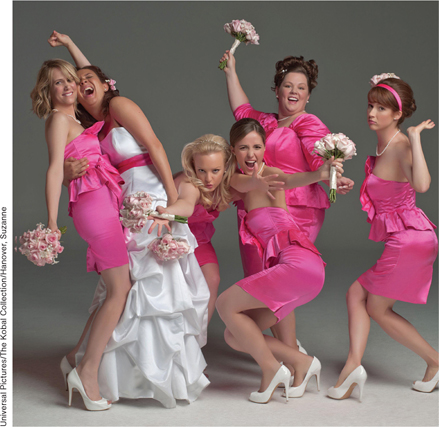13.1 Sources of Stress: What Gets to You
First of all, what are the sources of stress? A natural catastrophe, such as a hurricane, earthquake, or volcanic eruption, is an obvious source. But for most of us, stressors are personal events that affect the comfortable pattern of our lives and little annoyances that bug us day after day. Let’s look at the life events that can cause stress, chronic sources of stress, and the relationship between lack of perceived control and the impact of stressors.
Stressful Events
People often seem to get sick after major life events. In fact, simply adding up the stress ratings of each life change experienced is a significant indicator of a person’s likelihood of future illness (Miller, 1996). Someone who becomes divorced, loses a job, and has a friend die all in the same year, for example, is more likely to get sick than someone who escapes the year with only a divorce.
A checklist adapted for the life events of college students (and sporting the snappy acronym CUSS, for College Undergraduate Stress Scale) is shown in TABLE 13.1. To assess your stressful events, check off any events that have happened to you in the past year and sum your point total. In a large sample of students in an introductory psychology class, the average was 1,247 points, ranging from 182 to 2,571 (Renner & Mackin, 1998).
|
Event |
Stress Rating |
Event |
Stress Rating |
|---|---|---|---|
|
Being raped |
100 |
Lack of sleep |
69 |
|
Finding out that you are HIV positive |
100 |
Change in housing situation (hassles, moves) |
69 |
|
Being accused of rape |
98 |
Competing for performing in public |
69 |
|
Death of a close friend |
97 |
Getting in a physical fight |
66 |
|
Death of a close family member |
96 |
Difficulties with roommate |
66 |
|
Contracting a sexually transmitted disease (other than AIDS) |
94 |
Job changes (applying, new job, work hassles) |
65 |
|
Concerns about being pregnant |
91 |
Declaring your major or concerns about future plans |
65 |
|
Finals week |
90 |
A class you hate |
62 |
|
Concerns about your partner being pregnant |
90 |
Drinking or use of drugs |
61 |
|
Oversleeping for an exam |
89 |
Confrontations with professors |
60 |
|
Flunking a class |
89 |
Starting a new semester |
58 |
|
Having a boyfriend or girlfriend cheat on you |
85 |
Going on a first date |
57 |
|
Ending a steady dating relationship |
85 |
Registration |
55 |
|
Serious illness in a close friend or family member |
85 |
Maintaining a steady dating relationship |
55 |
|
Financial difficulties |
84 |
Commuting to campus or work or both |
54 |
|
Writing a major term paper |
83 |
Peer pressures |
53 |
|
Being caught cheating on a test |
83 |
Being away from home for the first time |
53 |
|
Drunk driving |
82 |
Getting sick |
52 |
|
Sense of overload in school or work |
82 |
Concerns about your appearance |
52 |
|
Two exams in one day |
80 |
Getting straight As |
51 |
|
Cheating on your boyfriend or girlfriend |
77 |
A difficult class that you love |
48 |
|
Getting married |
76 |
Making new friends, getting along with friends |
47 |
|
Negative consequences of drinking or drug use |
75 |
Fraternity or sorority rush |
47 |
|
Depression or crisis in your best friend |
73 |
Falling asleep in class |
40 |
|
Difficulties with parents |
73 |
Attending an athletic event |
21 |
|
Talking in front of class |
72 |
|
|
|
Note: To compute your personal life score, sum the stress ratings for all events that have happened to you in the last year. Source: Information from Renner and Mackin, 1998. |
|||
Where are you on the stress scale?
Looking at the list, you may wonder why positive events are included. Stressful life events are unpleasant, right? Why would getting married be stressful? Isn’t a wedding supposed to be fun? Research has shown that compared with negative events, positive events produce less psychological distress and fewer physical symptoms (McFarlane et al., 1980), and also that happiness can sometimes even counteract the effects of negative events (Fredrickson, 2000). However, positive events often require readjustment and preparedness that many people find extremely stressful (e.g., Brown & McGill, 1989), so these events are included in computing life-

Chronic Stressors
Life would be simpler if an occasional stressful event such as a wedding or a lost job were the only pressures we faced. At least each event would be limited in scope, with a beginning, a middle, and, ideally, an end. But unfortunately, life brings with it continued exposure to chronic stressors, sources of stress that occur continuously or repeatedly. Strained relationships, discrimination, bullying, overwork, money troubles—
chronic stressors
Sources of stress that occur continuously or repeatedly.
413
What are some examples of environmental factors that cause chronic stress?
Many chronic stressors are linked to social relationships. For instance, as described in the Social Psychology chapter, people often form different social groups based on race, culture, interests, popularity, and so on. Being outside the in-
414

Perceived Control over Stressful Events
What do catastrophes, stressful life changes, and daily hassles have in common? Right off the bat, of course, their threat to the person or the status quo is easy to see. Stressors challenge you to do something—to take some action to eliminate or overcome the stressor.
Paradoxically, events are most stressful when there is nothing to do—no way to deal with the challenge. Expecting that you will have control over what happens to you is associated with greater effectiveness in dealing with stress. The stressful effects of crowding, for example, appear to stem from the feeling that you can’t control getting away from the crowded conditions (Evans & Stecker, 2004). Being jammed into a crowded dormitory room may be easier to handle, after all, the moment you realize you could take a walk and get away from it all.
Hot Science: Can Discrimination Cause Stress and Illness?
Can Discrimination Cause Stress and Illness?
Have you ever been discriminated against because of your race, gender, sexual orientation, or some other characteristic? If so, then you know that this can be a pretty stressful experience. But what exactly does it do to people?
Recent research has shown that there are a number of ways that discrimination can lead to elevated stress and negative health outcomes. People from socially disadvantaged groups who experience higher levels of stress as a result of discrimination engage more frequently in maladaptive behaviors (e.g., drinking, smoking, and overeating) in efforts to cope with stress. They also can experience difficulties in their interactions with health care professionals (e.g., clinician biases, patient suspiciousness about treatment; Major, Mendes, & Dovidio, 2013). Together, these factors may help to explain why members of socially disadvantaged groups have significantly higher rates of health problems than do members of socially advantaged groups (Penner et al., 2010).
One recent study exposed Black and White participants to social rejection by either a person of the same race or a different race to test whether there is something particularly harmful about discrimination, versus social rejection in general (Jamieson et al., 2013). To test this idea, they had research participants deliver a speech to two confederates in different rooms via a video chat program, after which the confederates provided negative feedback about the participant’s speech. The confederates were not seen by a participant but were represented by computer avatars that either matched each participant’s race or did not. Interestingly, although the nature of the rejection was the same in all cases, participants responded very differently if the people rejecting them were from a different race. Specifically, whereas being rejected by people from your own race was associated with greater displays of shame and physiological changes associated with an avoidance state (increased cortisol), being rejected by members of a different race was associated with displays of anger, greater vigilance for danger, physiological changes associated with an approach state (i.e., higher cardiac output and lower vascular resistance), and higher risk taking.
Studies like this one help to explain some of the health disparities that currently exist across different social groups. The results suggest that discrimination can lead to physiological, cognitive, and behavioral changes that in the short term prepare a person for action but that in the long-
415
What makes events most stressful?
But what if you can’t get up and walk away from a stressful situation? A classic study by Overmeir and Seligman (1967) showed that if dogs are repeatedly exposed to electric shocks with no way to escape, then they later don’t even try to escape from shocks, even when escape is now possible. This learned helplessness, or the belief that one has no control over one’s situation based on past experience, has been proposed to be a major contributor to the development of depression in humans who have experienced repeated stressful events (Abramson, Seligman, & Teasdale, 1978).
learned helplessness
The belief that one has no control over one’s situation based on past experience.

SUMMARY QUIZ [13.1]
Question 13.1
| 1. | What kinds of stressors are you likely to be exposed to if you live in a dense urban area with considerable traffic, noise, and pollution? |
- cultural stressors
- intermittent stressors
- chronic stressors
- positive stressors
c.
Question 13.2
| 2. | In an experiment, two groups are subjected to loud noise while attempting to complete a task. The people in Group A are told they can turn off the noise by pushing a button. This information is withheld from Group B. Why will Group A’s performance at the task likely be better than Group B’s? |
- Group B is working in a different environment.
- Group A has perceived control over the stress.
- Group B is less distracted than Group A.
- The distractions affecting Group B are now chronic.
b.
Question 13.3
| 3. | According to the College Undergraduate Stress Scale, which of the following events is most stressful? |
- concerns about your appearance
- lack of sleep
- getting sick
- confrontation with professors
b.